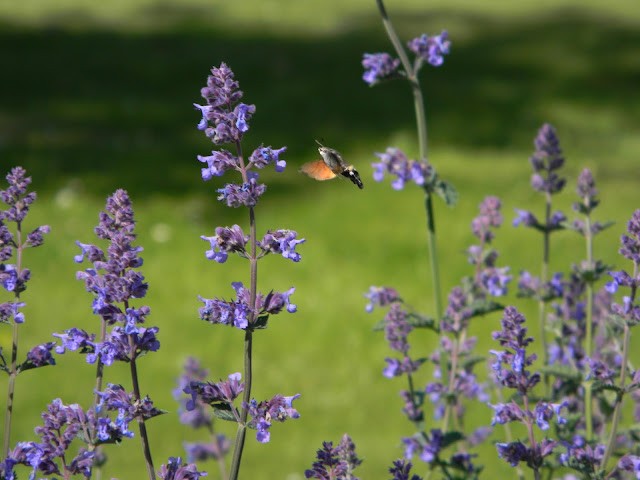Part of the Lamiaceae family of flowering plants, there are quite a number of different varieties of Nepeta commonly known as Catmint, but we will focus on probably on of the most popular, easiest to grow and most widely available variety here in Britain. Nepeta Gigantea 'Six Hills Giant'.
A vigorous perennial, Six Hills Giant requires up to 80cm x 80cm of space due to its rather floppy nature. It's leaves are a greenish grey and when flowering it throws up long spikes of mauve Lavender like flowers. It is one of the longest flowering plants of Summer and can bloom for months with little or no attention. Not surprisingly it is a great favourite of bees, butterflies, and hummingbird moths.
Depending on the season some gardeners decide to cut back Nepeta in the middle to late July in order for fresh growth to emerge and to bloom on into late Autumn. It has to be said I tend not to do this, finding enough colour if a little faded in late summer, but it is purely my personal preference. That said however and as with most perennials, old growth should be cut back and cleared in Autumn ready for new shoots next season. Nepeta grows best in a light loamy soil which is well drained and is happiest located in full sun. It is ideally located at the front or toward the middle of a large border and is well suited as a terrace of path edging. Feeding Catmint is not necessary as this only encourages the plant to become leggy and floppy but be sure to water well new plants at least for the first few weeks.
Nepeta of course is commonly called Catmint or Catnip for a very good reason best known to cats themselves. Our feline friends simply adore the stuff. Nepeta cataria with it's tall white flowers is the variety that seems to have the greatest effect. Cats rub themselves around the plant and play and roll on the leaves which makes them happy and relaxed in equal measure. My cat is always particularly eager to greet me if I've been working with Catmint that day. I should be noted that the effects are completely harmless.
Pictures: Southern England The Walnut tree pubs annual vintage gathering. A hummingbird hawk moth takes advantage of the blooming Nepeta.
General discussion and your views are welcome please say hello. I regret however because of my busy schedule, I am unable to answer many questions. Sneaky advertising will be deleted sorry. Thanks so much for visiting my blog today.
Pictures: Southern England The Walnut tree pubs annual vintage gathering. A hummingbird hawk moth takes advantage of the blooming Nepeta.
General discussion and your views are welcome please say hello. I regret however because of my busy schedule, I am unable to answer many questions. Sneaky advertising will be deleted sorry. Thanks so much for visiting my blog today.







No comments:
Post a Comment